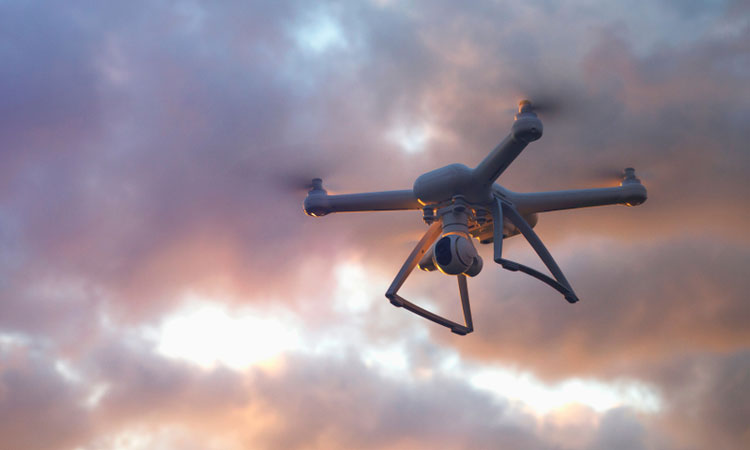They went mainstream only a few years ago, but drones are already making a big splash in the market.
copyright by www.internationalairportreview.com
 Thanks to the ability to buy them off of a shelf, drones are being adapted for commercial use. There are only so many human controllers can do though and, future drone models may not see this limitation thanks to the use of AI, freelance blogger Jake Carter tells us more. Artificial Intelligence, or AI, has existed for some time now. If we could develop an AI that could operate drones without humans, what could this mean? What sort of new opportunities could come from the melding of AI with drone technology? Moreover, what could go wrong?
Thanks to the ability to buy them off of a shelf, drones are being adapted for commercial use. There are only so many human controllers can do though and, future drone models may not see this limitation thanks to the use of AI, freelance blogger Jake Carter tells us more. Artificial Intelligence, or AI, has existed for some time now. If we could develop an AI that could operate drones without humans, what could this mean? What sort of new opportunities could come from the melding of AI with drone technology? Moreover, what could go wrong?
Thanks to the eye in the sky nature their cameras afford them, drones are an excellent way to get a birds-eye view of the land. Drone enthusiasts are already using this to get fantastic views of landscapes, which means that they can be used for things such as land surveillance and mapping, but they can go beyond such uses into realms like construction.
In March 2018, Chinese manufacturer DJI announced its most massive shipment of commercial drones. One thousand drones designed by U.S. drone company Skycatch were sold to Japanese construction company Komatsu. Each of these drones contains software designed by Skycatch that allows them run with minimal human interaction.
Webinar: How to implement an effective ATM strategy: The role of simulation and validation
This webinar will present HungaroControl’s simulation and validation capabilities.
Simulation is a key assessment technique in air traffic control used for training programs and for the validation of new concepts.
Will you be able to attend on 21 November at 9am GMT?
Thank you for reading this post, don't forget to subscribe to our AI NAVIGATOR!
The drones in question are the model Skycatch Explore1. Equipped with Skycatch’s software, the drone can create maps with accuracy within five centimetres. What’s more, the base station, Edge1, can process images without the need for Wi-Fi. The most impressive feature, though, is its own set of algorithms that can identify basic materials on a construction site, and take stock of how much is left.
What this means is that construction projects become more efficient. In a video demo for the Explore1, the drone was able to identify a potential design flaw in a construction site. This saved the site time and money that would have gone to correct the defect.
The Komatsu order is only one example of Skycatch’s increased popularity; their drones have already been used in sites around the world. Skycatch CEO Christian Sanz says, though, that the massive order shows that the industry’s growing: “Automation in construction is no longer something to look out for, four or five years in the future. When you go to a job site you should expect to see robots on the ground.”[…]
read more – copyright by www.internationalairportreview.com


They went mainstream only a few years ago, but drones are already making a big splash in the market.
copyright by www.internationalairportreview.com
Thanks to the eye in the sky nature their cameras afford them, drones are an excellent way to get a birds-eye view of the land. Drone enthusiasts are already using this to get fantastic views of landscapes, which means that they can be used for things such as land surveillance and mapping, but they can go beyond such uses into realms like construction.
In March 2018, Chinese manufacturer DJI announced its most massive shipment of commercial drones. One thousand drones designed by U.S. drone company Skycatch were sold to Japanese construction company Komatsu. Each of these drones contains software designed by Skycatch that allows them run with minimal human interaction.
Webinar: How to implement an effective ATM strategy: The role of simulation and validation
This webinar will present HungaroControl’s simulation and validation capabilities.
Simulation is a key assessment technique in air traffic control used for training programs and for the validation of new concepts.
Will you be able to attend on 21 November at 9am GMT?
Thank you for reading this post, don't forget to subscribe to our AI NAVIGATOR!
The drones in question are the model Skycatch Explore1. Equipped with Skycatch’s software, the drone can create maps with accuracy within five centimetres. What’s more, the base station, Edge1, can process images without the need for Wi-Fi. The most impressive feature, though, is its own set of algorithms that can identify basic materials on a construction site, and take stock of how much is left.
What this means is that construction projects become more efficient. In a video demo for the Explore1, the drone was able to identify a potential design flaw in a construction site. This saved the site time and money that would have gone to correct the defect.
The Komatsu order is only one example of Skycatch’s increased popularity; their drones have already been used in sites around the world. Skycatch CEO Christian Sanz says, though, that the massive order shows that the industry’s growing: “Automation in construction is no longer something to look out for, four or five years in the future. When you go to a job site you should expect to see robots on the ground.”[…]
read more – copyright by www.internationalairportreview.com
Share this: